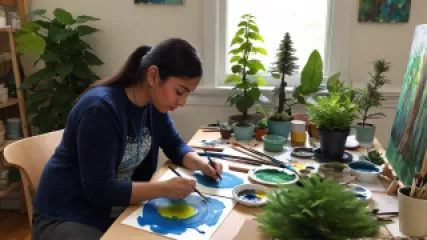How Can Art Workshops Improve Mental Health?
How Can Art Workshops Improve Mental Health?
In today's fast-paced and often stressful world, finding effective ways to improve mental health has become increasingly important. One approach that has gained significant attention in recent years is the use of art workshops as a therapeutic tool. But how exactly can these creative outlets enhance our overall well-being? Let's delve into the topic and explore the potential benefits of incorporating art workshops into our mental health regimen.
Unlocking the Power of Creative Expression
At the core of art workshops lies the concept of creative expression. By engaging in various art forms, individuals are given the opportunity to tap into their inner world, channeling their emotions, thoughts, and experiences through the medium of their choice. Whether it's painting, sculpting, drawing, or even collage-making, the act of creating art can serve as a powerful avenue for self-exploration and emotional processing.
Elbert Lewis, a renowned art therapist, explains, "When individuals participate in art workshops, they are not just creating pretty pictures. They are actively engaging in a process of self-discovery, where the artwork becomes a reflection of their inner landscape. This process can be deeply cathartic, allowing them to work through complex emotions and gain a deeper understanding of themselves."
Reducing Stress and Anxiety
One of the primary benefits of art workshops is their ability to alleviate stress and anxiety. In our constantly connected and fast-paced world, the demands of everyday life can often take a toll on our mental well-being. Art workshops provide a much-needed respite, offering a safe and nurturing space for individuals to step away from the stressors of daily life and immerse themselves in a creative activity.
As Nicholas Davidson, a clinical psychologist, explains, "When we engage in art-making, the brain experiences a shift in focus, moving away from the constant chatter of worries and anxieties. This shift can have a profound calming effect, allowing individuals to enter a state of flow and find a sense of relaxation and inner peace."
Moreover, the process of creating art has been shown to reduce the production of cortisol, the primary stress hormone. By lowering cortisol levels, art workshops can effectively alleviate the physiological symptoms of stress and anxiety, such as increased heart rate, muscle tension, and feelings of restlessness.
Boosting Self-Esteem and Confidence
Participating in art workshops can also have a positive impact on one's self-esteem and confidence. The act of creating something unique and meaningful can be a powerful affirmation of an individual's abilities and talents. As people engage in the creative process, they often experience a sense of accomplishment and pride in their work, which can translate into a greater sense of self-worth and confidence.
Noelle Hall, a social worker who facilitates art workshops, shares, "I've witnessed firsthand the transformative power of art workshops on individuals' self-perception. When someone creates a piece of art that they are truly proud of, it ignites a spark within them, a realization that they possess the capacity to express themselves in a meaningful way. This can be a powerful catalyst for building self-esteem and confidence."
Moreover, the act of sharing and showcasing one's artwork can further reinforce this positive self-image. By receiving affirmation and validation from others, participants in art workshops can feel a greater sense of belonging and acceptance, further boosting their self-confidence and self-worth.
Fostering Emotional Resilience
Art workshops can also play a crucial role in developing emotional resilience, which is the ability to bounce back from challenging life experiences. The creative process inherent in art-making can serve as a healthy coping mechanism, providing individuals with a constructive outlet to process and work through difficult emotions.
As Addison Morales, a mental health counselor, explains, "When we create art, we are engaging in a deeply personal and introspective journey. This process can help individuals come to terms with their emotions, whether they are feelings of grief, anger, or sadness. By channeling these complex emotions into their artwork, they are able to gain a sense of control and perspective, ultimately enhancing their emotional resilience."
Additionally, the sense of accomplishment and self-expression experienced through art-making can foster a greater sense of agency and empowerment. This can be particularly beneficial for individuals who have experienced trauma or other challenging life events, as it can help them reclaim a sense of control and build the necessary resilience to overcome adversity.
Cultivating Mindfulness and Presence
Another profound benefit of art workshops is their ability to cultivate mindfulness and presence. When individuals immerse themselves in the creative process, they are often required to focus their attention on the present moment, tuning out the distractions and mental chatter that can often consume our daily lives.
As Elbert Lewis explains, "The act of creating art demands a certain level of focus and attention. When people engage in art workshops, they are forced to be fully present, to be mindful of their senses, their movements, and the materials they are working with. This can have a tremendously calming and grounding effect, helping individuals to better regulate their emotions and achieve a greater sense of inner peace."
This heightened sense of mindfulness can also translate into other areas of an individual's life, as the skills developed through art-making can be applied to various daily tasks and challenges. By cultivating a greater awareness of the present moment, individuals can learn to better manage stress, improve their decision-making, and enhance their overall well-being.
Fostering Social Connections
Art workshops can also serve as a powerful tool for fostering social connections and reducing feelings of isolation. By engaging in a shared creative experience, participants have the opportunity to connect with others, share their stories, and build a sense of community.
As Nicholas Davidson explains, "Art workshops provide a unique platform for people to come together, to explore their creativity and their experiences in a safe and supportive environment. This sense of camaraderie and shared purpose can be incredibly valuable, especially for individuals who may be struggling with feelings of loneliness or social anxiety."
Moreover, the collaborative nature of certain art activities, such as group murals or collages, can further strengthen these social bonds. By working together towards a common creative goal, participants can develop a sense of shared purpose and belonging, which can have a profoundly positive impact on their overall mental health and well-being.
Unlocking Neurodivergent Potential
Art workshops can also serve as a powerful tool for individuals who identify as neurodivergent, such as those with autism, ADHD, or other neurological differences. These creative outlets can provide a safe and nurturing space for these individuals to explore their unique perspectives and talents, offering them an avenue for self-expression and personal growth.
Noelle Hall shares, "I've had the privilege of facilitating art workshops for neurodivergent individuals, and I've witnessed the incredible transformations that can occur. These individuals often thrive in the creative process, as it allows them to harness their unique sensory experiences and cognitive strengths in a way that traditional educational or therapeutic settings may not."
By embracing the diverse ways in which neurodivergent individuals perceive and interact with the world, art workshops can help foster a greater sense of self-acceptance and empowerment. This, in turn, can lead to enhanced self-esteem, improved emotional regulation, and a deeper understanding of one's own unique talents and abilities.
Accessible and Inclusive Spaces
One of the significant advantages of art workshops is their accessibility and inclusivity. Unlike traditional therapeutic modalities, which may require specialized training or resources, art workshops can be facilitated by a wide range of professionals, from social workers and counselors to art therapists and community organizers.
Addison Morales explains, "Art workshops can be designed to cater to a diverse range of participants, regardless of their previous artistic experience or skill level. The focus is on the process of creating, rather than the end product, which allows everyone to engage in a meaningful way."
Moreover, art workshops can be tailored to accommodate various physical, cognitive, or sensory needs, making them accessible to individuals from all walks of life. This inclusive approach can be particularly valuable for individuals who may have faced barriers in accessing traditional mental health services, providing them with a welcoming and supportive environment to explore their creative potential.
Unleashing Creativity and Imagination
Ultimately, the power of art workshops lies in their ability to unleash the boundless creativity and imagination that resides within each individual. By engaging in the creative process, participants are encouraged to step outside the confines of their everyday thoughts and experiences, and to explore new perspectives and possibilities.
As Elbert Lewis eloquently states, "Art workshops are not just about creating beautiful works of art; they are about tapping into the wellspring of our human potential. When we allow ourselves to be vulnerable, to engage in the act of creation, we unlock a world of possibilities - a world where our emotions, our stories, and our very essence can be expressed in profound and meaningful ways."
By embracing the transformative power of art workshops, individuals can embark on a journey of self-discovery, personal growth, and mental health enhancement. Whether it's finding solace in the act of painting, discovering a newfound passion for sculpting, or simply reveling in the joy of creating, these creative outlets have the potential to unlock a deeper understanding of ourselves and the world around us.
Conclusion
In conclusion, art workshops offer a multifaceted approach to improving mental health and well-being. From reducing stress and anxiety to fostering emotional resilience, these creative outlets can provide individuals with a powerful tool for self-expression, personal growth, and overall mental health enhancement.
By embracing the transformative power of art, we can unlock new pathways for healing, connection, and self-discovery. Whether you are seeking to alleviate the demands of daily life, explore your innermost thoughts and emotions, or simply indulge in the joy of creative expression, art workshops can offer a profound and meaningful journey towards better mental health.
So, if you're looking to embark on a path towards greater emotional well-being, consider exploring the world of art workshops and unlocking the healing potential of creative expression. Your mental health and overall quality of life may just be transformed in ways you never imagined.






